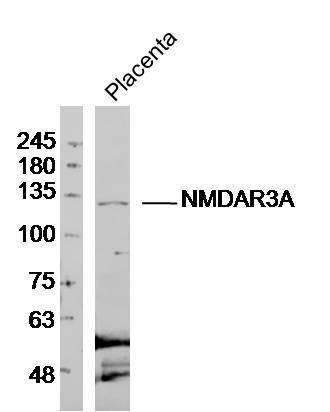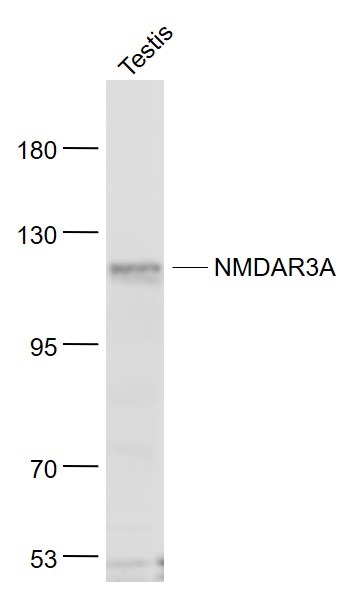Shopping Cart
Remove All Your shopping cart is currently empty
Your shopping cart is currently empty
Anti-NMDAR3A Polyclonal Antibody is a Rabbit antibody targeting NMDAR3A. Anti-NMDAR3A Polyclonal Antibody can be used in WB.
| Pack Size | Price | USA Warehouse | Global Warehouse | Quantity |
|---|---|---|---|---|
| 50 μL | $220 | 7-10 days | 7-10 days | |
| 100 μL | $373 | 7-10 days | 7-10 days | |
| 200 μL | $529 | 7-10 days | 7-10 days |
| Description | Anti-NMDAR3A Polyclonal Antibody is a Rabbit antibody targeting NMDAR3A. Anti-NMDAR3A Polyclonal Antibody can be used in WB. |
| Synonyms | NR3A, N-methyl-D-aspartate receptor subtype 3A, N-methyl-D-aspartate receptor, NMDAR-L1, NMDAR-L, NMDAR3A, NMD3A, GRIN3A, Glutamate [NMDA] receptor subunit 3A, Chi-1 |
| Ig Type | IgG |
| Reactivity | Mouse (predicted:Human,Rat,Dog,Rabbit) |
| Verified Activity | 1. Sample: Placenta (Mouse) lysate at 40 μg Primary: Anti-NMDAR3a (TMAB-01249) at 1/300 dilution Secondary: IRDye800CW Goat Anti-RabbitIgG at 1/20000 dilution Predicted band size: 123 kDa Observed band size: 123 kDa 2. Sample: Testis (Mouse) Lysate at 40 μg Primary: Anti-NMDAR3A (TMAB-01249) at 1/1000 dilution Secondary: IRDye800CW Goat Anti-Rabbit IgG at 1/20000 dilution Predicted band size: 123 kDa Observed band size: 123 kDa   |
| Application | |
| Recommended Dose | WB: 1:500-2000 |
| Antibody Type | Polyclonal |
| Host Species | Rabbit |
| Subcellular Localization | Cell membrane; Multi-pass membrane protein (By similarity). Cell junction, synapse, postsynaptic cell membrane (By similarity). Cell junction, synapse, postsynaptic cell membrane, postsynaptic density (By similarity). Note=Enriched in postsynaptic plasma membrane and postsynaptic densities. Requires the presence of GRIN1 to be targeted at the plasma membrane |
| Construction | Polyclonal Antibody |
| Purification | Protein A purified |
| Appearance | Liquid |
| Formulation | 0.01M TBS (pH7.4) with 1% BSA, 0.02% Proclin300 and 50% Glycerol. |
| Concentration | 1 mg/mL |
| Research Background | Glutamate receptors mediate most excitatory neurotransmission in the brain and play an important role in neural plasticity, neural development and neuro-degeneration. Ionotropic glutamate receptors are categorized into NMDA receptors and kainate/AMPA receptors, both of which contain glutamate-gated, cation-specific ion channels. Kainate/AMPA receptors co-localize with NMDA receptors in many synapses and consist of seven structurally related subunits designated GluR-1 to 7. The kainate/AMPA receptors are primarily responsible for fast excitatory neurotransmission by glutamate, whereas the NMDA receptors exhibit slow kinesis of Ca2+ ions and a high permeability for Ca2+ ions. One such NMDA receptor, NR3B, is expressed in motor neurons and forms cation channels impermeable to calcium, which can resist many open-channel blockers. NR3B functions in the brain as an excitatory glycine receptor, modifying the normal role of glycine as an inhibitory neurotransmitter. |
| Immunogen | KLH conjugated synthetic peptide: human NMDAR3A/NR3A |
| Antigen Species | Human |
| Gene Name | GRIN3B |
| Gene ID | |
| Protein Name | Glutamate receptor ionotropic, NMDA 3B |
| Uniprot ID | |
| Biology Area | NMDA Receptors |
| Function | NMDA receptor subtype of glutamate-gated ion channels with reduced single-channel conductance, low calcium permeability and low voltage-dependent sensitivity to magnesium. Mediated by glycine. |
| Molecular Weight | Theoretical: 123 kDa. |
| Stability & Storage | Store at -20°C or -80°C for 12 months. Avoid repeated freeze-thaw cycles. |
| Transport | Shipping with blue ice. |
| Size | Quantity | Unit Price | Amount | Operation |
|---|

Copyright © 2015-2026 TargetMol Chemicals Inc. All Rights Reserved.